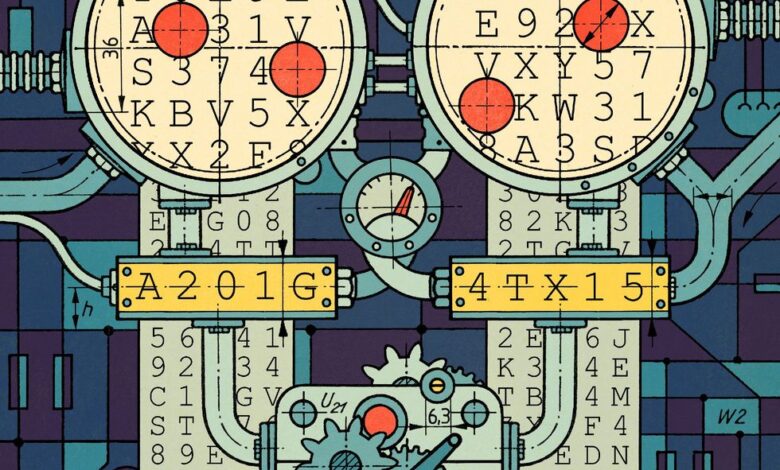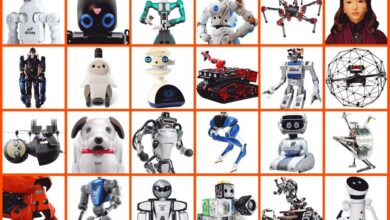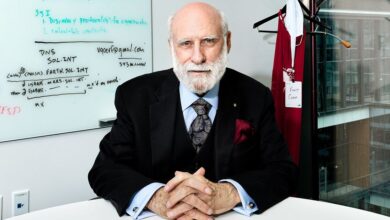This AI-Powered Invention Machine Automates Eureka Moments

Just outside Lausanne, Switzerland, in a meeting room wallpapered with patent drawings, Ioannis Ierides faced a classic sales challenge: demonstrating his product’s advantages within the short span of his customer’s attention. Ierides is a business-development manager at Iprova, a company that sells ideas for invention with an element of artificial intelligence (AI).
When Ierides gets someone to sign on the bottom line, Iprova begins sending their company proposals for patentable inventions in their area of interest. Any resulting patents will name humans as the inventors, but those humans will have benefited from Iprova’s AI tool. The software’s primary purpose is to scan the literature in both the company’s field and in far-off fields and then suggest new inventions made of old, previously disconnected ones. Iprova has found a niche tracking fast-changing industries and suggesting new inventions to large corporations such as Procter & Gamble, Deutsche Telekom, and Panasonic. The company has even patented its own AI-assisted invention method.
In this instance, Ierides was trying to demonstrate to me, an inquisitive journalist, that Iprova’s services can accelerate the age-old engineers’ quest for new inventions. “You want something that can transcribe interviews? Something that can tell who’s speaking?” he asked. While such transcription tools already exist, there is plenty of room for improvement, and better transcription seemed a fine example for our purposes.
Ierides typed some relevant search terms into Iprova’s software, which displayed a pie chart with concentric circles, whose every slice represented a different research area. “This is the scoping step,” he said. As he put in more text, the circle broke apart into the more relevant constituent slices. The software used its semantic-search capabilities to detect similarities to his prompt in its enormous text corpus, which included patents, peer-reviewed articles, and other technology-related texts from the Internet. (Since our meeting, Iprova has replaced the pie chart workflow with a new one.)
Ierides called the next step “sensing and connecting.” The software presented short text summaries of the material it considered relevant, and Ierides highlighted with his cursor the ones he found interesting. Then he clicked a button marked “generate connection,” and the software displayed a proposal for our machine transcriber in a paragraph so dry, but also so clear that not even a machine editor would have changed a word.
Iprova’s system suggested I combine a new type of high-quality microphone with two new software programs that can identify speakers by their personal speech patterns. “As you can see this is a fairly ‘obvious’ invention, since we did not use the tool to its full capability,” Ierides wrote in a later email. In the real world, Iprova inventors would iterate the search, scan related patents, and check in with their clients. To get to a less obvious invention than ours, Iprova inventors might challenge the software to find connections between more distant fields.
Trying to Automate Invention
The inventors at Iprova might also, in the time-honored tradition, stare out the window, doodle on some paper with a pen, or build something unrelated to the task at hand before arriving at an exciting new idea. That new concept would almost surely be the product of an unplanned collision of unconnected ideas and points of view. It would likely be serendipitous.
“If you tell someone you can do this in a more reliable, substantial way, they don’t believe it,” says Iprova’s cofounder and CEO Julian Nolan. Nolan spends a lot of time persuading potential clients that the company’s software offers the right mix of AI literature-scanning and human insights, which will help these clients to invent new technologies faster than the competition. “Invention is a winner-takes-all activity,” he says. “If you’re second, you’re too late.”
“Invention is a winner-takes-all activity. If you’re second, you’re too late.” –Julian Nolan
The company finds ideas on the cutting edge of the cutting edge. Take, for example, the time that Panasonic asked Iprova for help finding new uses for autonomous vehicles. The software suggested giving the cars jobs when their human passengers weren’t using them, such as delivering parcels—essentially making them self-driving gig workers. It even suggested that human passengers might be willing to take the scenic route, or at least routes involving picking up or dropping off parcels, for the right discount on their ride. Panasonic bought that idea and filed a patent application in 2021.
“They’re at the confluence of competitive intelligence and patent law,” says Eric Bonabeau, chief technology officer of Biomedit, in Berkeley, Calif., who has not worked with Iprova. Using AI to discover patentable ideas is not the new part—that’s been going on for years. In 2021, the inventor Stephen L. Thaler and attorney Ryan Abbott even got the South African patent office to recognize Thaler’s AI system as the co-inventor of a food container (patent offices in other countries have rejected his applications).
“The new thing we have is an incredible generation machine,” Bonabeau says, referring to the large language models produced by generative AI that have emerged in the last few years. Those language models allow Iprova to summarize an enormous body of training texts—patent databases and other technological publications including peer-reviewed articles, industry technical standards, and non-peer-reviewed text. Iprova’s invention engineers have named this constantly updating trove of the world’s newest technical ideas “the Index.” Iprova’s search tools wend their way through the Index, hunting for the most helpful signals of novelty, while different tools rate existing inventions within the client’s domain. Searches that turn up strong novelty signals but weak existing inventions reveal places where inventors might add something both new and useful.
One such Iprova invention straddles a pair of seemingly disparate research areas: lithium batteries and message encryption. Ericsson, the mobile-phone company based in Stockholm, asked Iprova for a way of generating unique encryption keys known only to the users of two mobile devices.
Christian Gralingen
A typical cryptologist might not know much about how lithium batteries form tiny projections called dendrites during their cycles of charging and discharging. But Iprova’s software surfaced the fact that lithium dendrites represented an example of natural randomness, which is at the root of reliable encryption. The lithium batteries inside modern mobile phones each degrade in their own random ways and each battery has its own ever-changing magnetic signature as a result. A mobile device, held near another, can measure that fleeting magnetic signature and use it to generate an encryption key that nobody could replicate, given the batteries’ subsequent random degradation. The invention resulted in multiple patents.
Not every patent leads to an invention that someone will build. Companies sometimes rely on patents to help protect their intellectual property; the existence of those patents may deter competitors from offering something closely related. In other cases, a company may lay claim to ideas it later determines aren’t commercially mature or which don’t align with its mission. The company may use the ideas later or license them to another firm. The uncharitable might call this practice patent trolling, but it’s probably an inevitable result of the patent system: Companies will always generate more ideas than they can pursue.
Using Iprova’s software to generate scattershot inventions in the hopes of collecting license fees on the patents wouldn’t work as a business model, says Harry Cronin, the company’s head of standards. For one thing, Iprova’s own staff aren’t specialized enough to generate many market-ready ideas on their own: “We need the steer from the clients,” he says. Even if they could be AI-powered patent trolls, Cronin says, “Nobody at Iprova wants to do that.”
Invention in an Age of Information Overload
No one engineer, no matter how well-read, can be an expert across all potentially useful domains. At a June industry meeting that Iprova organized, Cronin gave a talk about how difficult it is becoming these days for engineers to keep up with all the telecom standards. A pacemaker that can connect to a 5G network must comply with both health standards and telecom standards. A drone must also meet aviation requirements. As the Internet’s wireless tentacles reach into more and more devices, telecom engineers cannot keep up with all the rules.
Iprova found the problem of proliferating telecom standards so attractive that it built a module for its software to track the industry’s so-called 3GPP standards and help inventors make new 3GPP-compatible inventions. The tool can push through the “wall of jargon” in the original standards texts, Cronin said, and identify useful similarities.
Bonabeau’s company, Biomedit, does something similar to invent new peptides using AlphaFold, the biology-focused generative-AI tool from DeepMind. Bonabeau says the generative component has revolutionized their company’s workflow, enabling Biomedit to identify successful peptides while synthesizing thousands fewer candidates. Generative AI is “baked into our process,” he says.
Iprova’s approach differs because it focuses on physical inventions, rather than biological ones. A biological invention is like a hypothesis—it requires a wet lab and time to confirm it works—while a physical invention is more like a mathematical proof. The inventor, the client, and in the final test, a patent examiner, should all be able to see the novelty and the value in the text description.
This insight may be the machine’s weak point. Nolan often uses the analogy of cooking, saying that while a machine can suggest ingredients that a cook might not know about, a human can intuit—or find out fast—how best to combine them. Bonabeau suggested the same analogy after examining Iprova’s case studies. “The human is in the loop exactly where I would put him or her,” Bonabeau says. “We know the machine isn’t able to assess whether something is interesting or not.”
Others agree. “AI really can’t invent,” said research fellow Paul Sagel, of Procter & Gamble, during a panel at Iprova’s June meeting. “It has to have some element of human assistance…otherwise it hallucinates.”
Or maybe those are just things we’ll tell ourselves as we get more comfortable with the idea of AI invention. Thaler, Abbott, and others are trying to lay the legal groundwork for granting patents to AI systems. And we’ll learn what AI is capable of as different inventors use it in opposing ways. Nolan, for example, told attendees at the June meeting about the power of delivering a predictable number of inventions to clients each week, of harnessing serendipity. Regularly scheduled eureka moments are useful to clients, he said. Bonabeau, on the other hand, embraces the chaos he sees in AI invention. “I personally love [generative AI] hallucinations. For me, they’re one of the big sources of innovation, kind of a mushroom trip. I’m looking for weird connections.”
Much of what people call AI are advanced forms of pattern recognition. That includes recognizing patterns in other people’s inventions. Public inventions have a creative footprint, Nolan says. “If you have enough examples of the paintings of a painter, then you can mimic their style. Perhaps the same is true of inventors.”
And what are companies but groups of people, with their own identifiable collective patterns? A clever-enough AI, guided by a clever human, might even recognize the patterns in a given company’s patent filings. Mixed with the right generative AI, that combination might open the door to anticipating a competitor’s moves. But what if the competitor is itself using AI to generate inventions? Then, perhaps, an invention-producing AI will predict another invention-producing AI’s next invention.
IEEE Spectrum



